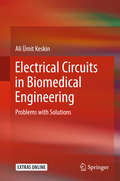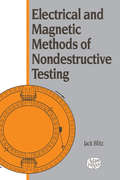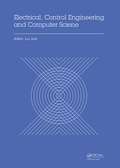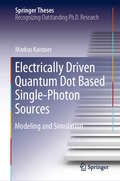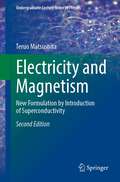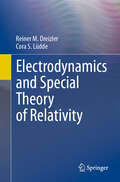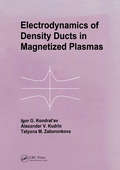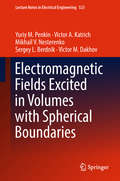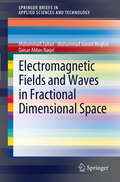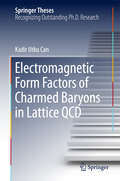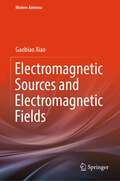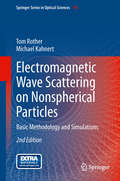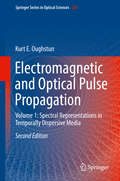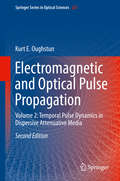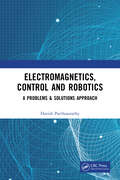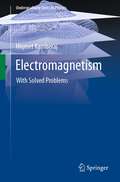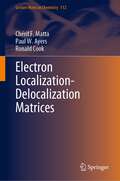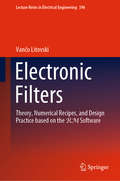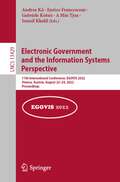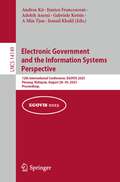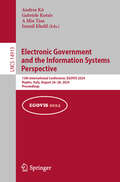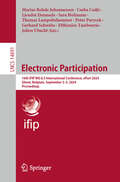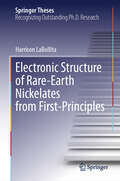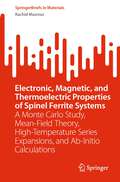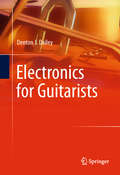- Table View
- List View
Electrical Circuits in Biomedical Engineering
by Ali Ümit KeskinThis book presents a comprehensive and in-depth analysis of electrical circuit theory in biomedical engineering, ideally suited as textbook for a graduate course. It contains methods and theory, but the topical focus is placed on practical applications of circuit theory, including problems, solutions and case studies. The target audience comprises graduate students and researchers and experts in electrical engineering who intend to embark on biomedical applications.
Electrical and Magnetic Methods of Nondestructive Testing
by Jack BlitzElectrical and Magnetic Methods of Nondestructive Testing presents a comprehensive account of the electrical and magnetic methods of nondestructive testing (NDT). The book begins with a discussion of the requirements for NDT and the criteria for the choice of a given method, followed by a summary of the general theory relating to electrical and magnetic testing techniques. Subsequent chapters discuss specific methods, including eddy current and flux-leakage techniques and microwave and potential drop methods. The appendix provides some useful programs for eddy current impedance analyses. These programs are in BASIC and can be run on PCs.
Electrical, Control Engineering and Computer Science: Proceedings of the 2015 International Conference on Electrical, Control Engineering and Computer Science (ECECS 2015, Hong Kong, 30-31 May 2015)
by Jian LiuElectrical, Control Engineering and Computer Science includes the papers from ECECS2015 (Hong Kong, 30-31 May 2015), which was organized by the American Society of Science and Engineering (ASEE), a non-profit society for engineers and scientists. Presenting new theories, ideas, techniques and experiences related to all aspects of electrical enginee
Electrically Driven Quantum Dot Based Single-Photon Sources: Modeling and Simulation (Springer Theses)
by Markus KantnerSemiconductor quantum optics is on the verge of moving from the lab to real world applications. When stepping from basic research to new technologies, device engineers will need new simulation tools for the design and optimization of quantum light sources, which combine classical device physics with cavity quantum electrodynamics. This thesis aims to provide a holistic description of single-photon emitting diodes by bridging the gap between microscopic and macroscopic modeling approaches. The central result is a novel hybrid quantum-classical model system that self-consistently couples semi-classical carrier transport theory with open quantum many-body systems. This allows for a comprehensive description of quantum light emitting diodes on multiple scales: It enables the calculation of the quantum optical figures of merit together with the simulation of the spatially resolved current flow in complex, multi-dimensional semiconductor device geometries out of one box. The hybrid system is shown to be consistent with fundamental laws of (non-)equilibrium thermodynamics and is demonstrated by numerical simulations of realistic devices.
Electricity and Magnetism: New Formulation by Introduction of Superconductivity (Undergraduate Lecture Notes in Physics)
by Teruo MatsushitaThis book is a very comprehensive textbook covering in great depth all the electricity and magnetism. The 2nd edition includes new and revised figures and exercises in many of the chapters, and the number of problems and exercises for the student is increased.In the 1st edition, emphasis much was made of superconductivity, and this methodology will be continued in the new edition by strengthening of the E-B analogy. Many of the new exercises and problems are associated with the E-B analogy, which enables those teaching from the book to select suitable teaching methods depending on the student’s ability and courses taken, whether physics, astrophysics, or engineering.Changes in the chapters include a detailed discussion of the equivector-potential surface and its correspondence between electricity and magnetism. The shortcomings of using the magnetic scalar potential are also explained. The zero resistivity in a magnetic material showing perfect diamagnetism can be easily proved.This textbook is an ideal text for students, who are competent in calculus and are taking physics, astrophysics, or engineering at degree level. It is also useful as a reference book for the professional scientist.
Electrodynamics and Special Theory of Relativity
by Reiner M. Dreizler Cora S. LüddeThis textbook offers you a profound understanding of the core concepts in electrodynamics and the special theory of relativity. Emphasis is placed on establishing strong mathematical fundamentals while also equipping you with problem-solving skills crucial for mastering these disciplines. It covers electromagnetic theory, encompassing Maxwell's equations and electromagnetic wave theory as well as special theory of relativity, including space-time principles and the Lorentz transformation.
Electrodynamics of Density Ducts in Magnetized Plasmas: The Mathematical Theory of Excitation and Propagation of Electromagnetic Waves in Plasma Waveguides
by I G Kondratiev A V Kudrin T M ZaboronkovaProviding a systematic and self-contained treatment of excitation, propagation and re- emission of electromagnetic waves guided by density ducts in magnetized plasmas, this book describes in detail the theoretical basis of the electrodynamics of ducts. The classical dielectric-waveguide theory in open guiding systems in magnetoplasma is subjected to rigorous generalization. The authors emphasize the conceptual physical and mathematical aspects of the theory, while demonstrating its applications to problems encountered in actual practice. The opening chapters of the book discuss the underlying physical phenomena, outline some of the results obtained in natural and artificial density ducts, and describe the basic theory crucial to understanding the remainder of the book. The more specialized and complex topics dealt with in subsequent chapters include the theory of guided wave propagation along axially uniform ducts, finding the field excited by the source in the presence of a duct, excitation of guided modes, the asymptotic theory of wave propagation along axially nonuniform ducts, and mode re-emission from a duct. The full wave theory is used throughout most of the book to ensure consistency, and the authors start with simpler cases and gradually increase the complexity of the treatment.
Electromagnetic Fields Excited in Volumes with Spherical Boundaries (Lecture Notes In Electrical Engineering #523)
by Victor A. Katrich Yuriy M. Penkin Sergey L. Berdnik Mikhail V. Nesterenko Victor M. DakhovThis book discusses the problem of electromagnetic wave excitation in spatial regions with spherical boundaries and the accurate mathematical modeling based on numerical and analytical methods to significantly reduce the time required for developing new antenna devices. It particularly focuses on elements and systems on mobile objects of complex shape that are made of new technological materials. The experimental development of such devices and systems is an extremely time-consuming, lengthy, and expensive process. The book is intended for senior and postgraduate students and researchers working in the fields of radiophysics, radio engineering and antenna design. The authors assume that readers understand the basics of vector and tensor analysis, as well as the general theory of electrodynamics. The original results presented can be directly used in the development of spherical antennas and antenna systems for the mobile objects. The book addresses problems concerning the construction of Green’s functions for Hertz potentials in electrodynamic volumes with spherical boundaries, and solves these clearly and concisely. It also uses specific examples to analyze areas where the results could potentially be applied. The book covers the following topics: · excitation of electromagnetic fields in coordinate electrodynamic volumes; · Green’s functions for spherical resonators; · Green’s functions for infinite space outside of spherical scatterers; · electromagnetic fields of dipole radiators on spherical scatterers; · electromagnetic fields of thin radial impedance vibrators on perfectly conducting spheres; · electrodynamic characteristics of narrow slots in spherical surfaces; · multi-element and combined vibrator-slot radiators on spherical surfaces.
Electromagnetic Fields and Waves in Fractional Dimensional Space
by Muhammad Zubair Qaisar Abbas Naqvi Muhammad Junaid MughalThis book presents the concept of fractional dimensional space applied to the use of electromagnetic fields and waves. It provides demonstrates the advantages in studying the behavior of electromagnetic fields and waves in fractal media. The book presents novel fractional space generalization of the differential electromagnetic equations is provided as well as a new form of vector differential operators is formulated in fractional space. Using these modified vector differential operators, the classical Maxwell's electromagnetic equations are worked out. The Laplace's, Poisson's and Helmholtz's equations in fractional space are derived by using modified vector differential operators.
Electromagnetic Form Factors of Charmed Baryons in Lattice QCD (Springer Theses)
by Kadir Utku CanThis thesis presents the first lattice quantum chromodynamics (QCD) approach to the charmed baryon regime, building on the knowledge and experience gained with former lattice QCD applications to nucleon structure. The thesis provides valuable insights into the dynamics of yet unobserved charmed baryon systems. Most notably, it confirms that the expectations of model or effective field theoretical calculations of heavy-hadron systems hold qualitatively, while also demonstrating that they conflict with the quantitative results, pointing to a tension between these complementary approaches. Further, the book presents a cutting-edge approach to understanding the structure and dynamics of hadrons made of quarks and gluons using QCD, and successfully extends the approach to charmed hadrons. In particular, the thesis investigate a peculiar property of charmed hadrons whose dynamics, i.e., structure, deviates from their counterparts, e.g., those of protons and neutrons, by employing the lattice QCD approach —a state-of-the-art numerical method and the powerful ab initio, non-perturbative method.
Electromagnetic Sources and Electromagnetic Fields (Modern Antenna)
by Gaobiao XiaoThis book presents a modified spherical harmonic expansion method in which the electromagnetic fields and their sources are expanded with the same set of spherical vector basis functions in a similar procedure. Explicit expressions for the electromagnetic fields, potentials, energies, and the related Green’s functions are derived for the spherical modes in both frequency domain and time domain. Based on the formulation, the relationships between the electromagnetic sources, the electromagnetic far fields, and the electromagnetic near fields are clearly revealed. In particular, a nonuniform transmission line model is developed for intuitively characterizing the total radiation process. The introduction of the cutoff radius and the cutoff mode degree provides a simple reference for determining the numbers of degrees of freedom of the fields associated with sources in a bounded region. Based on the theory, an efficient hybrid method for synthesizing antenna arrays with complex footprints is proposed and demonstrated with several numerical examples. Effective algorithms are also developed for reconstructing the radiating part of the current sources.This book is intended for researchers, engineers, and graduate students who are interested in studying the energy transfer in electromagnetic radiation, synthesis and measurement of antenna arrays, and applications of inverse electromagnetic source problems.
Electromagnetic Wave Scattering on Nonspherical Particles
by Tom Rother Michael KahnertThis book gives a detailed overview of the theory of electromagnetic wave scattering on single, homogeneous, but nonspherical particles. Beside the systematically developed Green's function formalism of the first edition this second and enlarged edition contains additional material regarding group theoretical considerations for nonspherical particles with boundary symmetries, an iterative T-matrix scheme for approximate solutions, and two additional but basic applications. Moreover, to demonstrate the advantages of the group theoretical approach and the iterative solution technique, the restriction to axisymmetric scatterers of the first edition was abandoned.
Electromagnetic and Optical Pulse Propagation: Volume 1: Spectral Representations in Temporally Dispersive Media (Springer Series in Optical Sciences #224)
by Kurt E. OughstunThis volume presents a detailed, rigorous treatment of the fundamental theory of electromagnetic pulse propagation in causally dispersive media that is applicable to dielectric, conducting, and semiconducting media. Asymptotic methods of approximation based upon saddle point methods are presented in detail.
Electromagnetic and Optical Pulse Propagation: Volume 2: Temporal Pulse Dynamics in Dispersive Attenuative Media (Springer Series in Optical Sciences #225)
by Kurt E. OughstunIn two volumes, this book presents a detailed, systematic treatment of electromagnetics with application to the propagation of transient electromagnetic fields (including ultrawideband signals and ultrashort pulses) in dispersive attenuative media. The development in this expanded, updated, and reorganized new edition is mathematically rigorous, progressing from classical theory to the asymptotic description of pulsed wave fields in Debye and Lorentz model dielectrics, Drude model conductors, and composite model semiconductors. It will be of use to researchers as a resource on electromagnetic radiation and wave propagation theory with applications to ground and foliage penetrating radar, medical imaging, communications, and safety issues associated with ultrawideband pulsed fields. With meaningful exercises, and an authoritative selection of topics, it can also be used as a textbook to prepare graduate students for research. Volume 2 presents a detailed asymptotic description of plane wave pulse propagation in dielectric, conducting, and semiconducting materials as described by the classical Lorentz model of dielectric resonance, the Rocard-Powles-Debye model of orientational polarization, and the Drude model of metals. The rigorous description of the signal velocity of a pulse in a dispersive material is presented in connection with the question of superluminal pulse propagation. The second edition contains new material on the effects of spatial dispersion on precursor formation, and pulse transmission into a dispersive half space and into multilayered media. Volume 1 covers spectral representations in temporally dispersive media.
Electromagnetics, Control and Robotics: A Problems & Solutions Approach
by Harish ParthasarathyThis book covers a variety of problems, and offers solutions to some, in:• Statistical state and parameter estimation in nonlinear stochastic dynamical system in both the classical and quantum scenarios.• Propagation of electromagnetic waves in a plasma as described by the Boltzmann Kinetic Transport Equation.• Classical and Quantum General Relativity. It will be of use to Engineering undergraduate students interested in analysing the motion of robots subject to random perturbation, and also to research scientists working in Quantum Filtering.
Electromagnetism: With Solved Problems (Undergraduate Texts in Physics)
by Hiqmet KamberajAny curriculum involving science and/or engineering will eventually find itself entering the realm of physics. This book seeks to introduce students to a number of the fundamental concepts in physics and illustrate how different theories were developed out of physical observations and phenomena. The book presents multi-chapter sections on electrostatics, magnetism and electromagnetic waves, with eyes on both the past and the future, touching, along the way, on Coulomb, Gauss, Maxwell, Ohm, Biot-Savart, Ampere, Faraday, Fresnel and Lorentz. The book also contains an appendix that provides the reader with a portion of the mathematical background of vector analysis and vector differential operators. The book approaches its topics through a focus on examples and problem-solving techniques, illustrating vividly how physical theories are applied to problems in engineering and science. The book is primarily aimed at undergraduate students in these two fields, but it also features chapters that are geared towards senior undergraduates working on their final year theses.
Electron Localization-Delocalization Matrices (Lecture Notes in Chemistry #112)
by Chérif F. Matta Ronald Cook Paul W. AyersThis book builds bridges between two yet separated branches of theoretical and mathematical chemistry: Chemical Graph Theory and Electronic Structure Calculations. Although either of the fields have developed their own techniques, problems, methods, and favorite benchmark cases independent from each other, the authors have managed to bring them together by using the localization-delocalization matrix (LDM). The LDM is a novel molecular descriptor that fingerprints a molecule by condensing the complicated electronic information in one, mathematically manageable, object. In this book, the authors introduce the readers to modeling techniques based on LDMs. Their technique offers a high accuracy as well as robust predictive power, often dramatically surpassing the potential of either of the constituting methods on their own. In addition to the comprehensive and accessible introduction to this new field of theoretical chemistry, the authors offer their self-developed software free to download, so that readers can try running their own simulations. The described methods are very general and can easily be implemented for calculating various properties and parameters such as mosquito repelling activity, ionic liquid properties, local aromaticity of ring molecules, log P's, pKa's, LD50, corrosion inhibition activities, and Lewis acidities and basicities – to only name a few. The free downloadable software helps readers automate the analysis of the matrices described in this book and hence facilitates application of the described methodology.
Electronic Filters: Theory, Numerical Recipes, and Design Practice based on the RM Software (Lecture Notes in Electrical Engineering #596)
by Vančo LitovskiThis book provides a comprehensive overview of signal filtering, including an introduction, definitions of the terms and algorithms for numerical calculation of the properties of the transfer function in frequency and time domains. All the chapters discuss the theoretical background and explain the underlying algorithms including the iterative numerical procedures necessary to obtain the solutions. It starts by considering polynomial filters, offering a broad range of solutions and introducing critical monotonic passband amplitude characteristics (CMAC). It also describes modifications to the classical Chebyshev and elliptic filters to overcome their limitations. In the context linear phase low-pass prototypes, it presents filters approximating constant group delay in the equi-ripple manner for the first time. Further, it discusses new procedures to improve the selectivity of all polynomial filters by introducing transmission zeros, such as filters with multiple transmission zeros on the omega axis, as well as phase correction of selective filters for both low-pass and band-pass filters. Other topics explored include linear phase all-pass (exhibiting low-pass group delay approximation) filters; all-pass filters (exhibiting band-pass group delay approximation) with linear and parabolic phase synthesized directly as band-pass; high-pass, and band-stop amplitude characteristic frequency transformations to produce band-pass; and direct synthesis of linear and parabolic phase selective band-pass filters synthesized directly as band-pass. Lastly, for system (physical) synthesis, the book describes the algorithms and procedures for the following: cascade passive LC; active cascade RC; active parallel RC (for the first time); active parallel SC; Gm-C based on LC prototypes; and parallel IIR based on bilinear transformation of analog prototypes. Every algorithm, be it in transfer function synthesis or in system synthesis, is accompanied by a proper nontrivial comprehensive example produced by the RM software.
Electronic Government and the Information Systems Perspective: 11th International Conference, EGOVIS 2022, Vienna, Austria, August 22–24, 2022, Proceedings (Lecture Notes in Computer Science #13429)
by Enrico Francesconi Andrea Kő Ismail Khalil A Min Tjoa Gabriele KotsisThis volume LNCS 12429 constitutes the papers of the 11th International Conference on Electronic Government and the Information Systems Perspective, EGOVIS 20221, held in Vienna, Austria, in August 2022. The 11 full papers presented were carefully reviewed and selected from 16 submissions and focus on information systems and ICT aspects of e-government. The papers are organized in 3 topical sections: e-government theoretical background; semantic technologies and legal issues;; artificial intelligence and machine learning in e-government context.
Electronic Government and the Information Systems Perspective: 12th International Conference, EGOVIS 2023, Penang, Malaysia, August 28–30, 2023, Proceedings (Lecture Notes in Computer Science #14149)
by Enrico Francesconi Ismail Khalil A Min Tjoa Gabriele Kotsis Andrea Kö Adeleh AsemiThis book constitutes the proceedings of the 12th International Conference on Electronic Government and the Information Systems Perspective, EGOVIS 2023, which took place in Penang, Malaysia, during August 28-30, 2023.The 8 full papers presented together with 1 short paper were carefully reviewed and selected from a total of 17 submissions. They were organized in topical sections as follows: e-Government; strategy; artificial intelligence.
Electronic Government and the Information Systems Perspective: 13th International Conference, EGOVIS 2024, Naples, Italy, August 26–28, 2024, Proceedings (Lecture Notes in Computer Science #14913)
by Ismail Khalil A Min Tjoa Gabriele Kotsis Andrea KöThis book constitutes the proceedings of the 13th International Conference on Electronic Government and the Information Systems Perspective, EGOVIS 2024, which took place in Naples, Italy, in August 2024. The 10 full and 5 short papers included in this book were carefully reviewed and selected from 24 submissions. They were organized in topical sections as follows: AI in E-Government; E-Government cases; mobile government and digital inclusion; open government data and security.
Electronic Participation: 16th IFIP WG 8.5 International Conference, ePart 2024, Ghent, Belgium, September 3–5, 2024, Proceedings (Lecture Notes in Computer Science #14891)
by Sara Hofmann Efthimios Tambouris Peter Parycek Thomas Lampoltshammer Csaba Csáki Gerhard Schwabe Marius Rohde Johannessen Jolien Ubacht Lieselot DanneelsThis book constitutes the refereed proceedings of the 16th IFIP WG 8.5 International Conference on Electronic Participation, ePart 2024, held in Ghent, Belgium, during September 3–5, 2024. The 15 full papers included in this book were carefully reviewed and selected from 35 submissions. The conference is dedicated to digital or electronic government, open government, local government (smart cities), smart governance, artificial intelligence (AI), e-democracy, policy informatics, and electronic participation.
Electronic Structure of Rare-Earth Nickelates from First-Principles (Springer Theses)
by Harrison LaBollitaThis thesis demonstrates the value of theoretical approaches in the discovery of new superconducting materials. It reports a detailed study of the recently discovered nickel-oxide (nickelate) superconductors using multiple first-principles computational tools, from density functional theory to dynamical mean field theory. In the context of superconductivity, discoveries have generally been linked to serendipitous experimental discovery; this thesis reports some of the few examples of predictions of new superconductors that have later been realized in practice, a prime example of the significance of the methodology it expounds. Overall, it represents a seminal systematic work in the electronic structure theory of the emergent field of nickelate superconductivity.
Electronic, Magnetic, and Thermoelectric Properties of Spinel Ferrite Systems: A Monte Carlo Study, Mean-Field Theory, High-Temperature Series Expansions, and Ab-Initio Calculations (SpringerBriefs in Materials)
by Rachid MasrourThis book explores magnetic properties and critical temperatures in inverse ferrite Fe₃⁺(M₂⁺Fe₃⁺)O₄ spinels (e.g., Fe, Co, Ni). It calculates transition and Curie Weiss temperatures, providing insights into their thermodynamic behavior. Using the full potential linearized augmented plane wave (FP-LAPW) method, it investigates electrical and magnetic structures of spinel chromite, revealing magnetic moments in MnCr₂S₄. Seebeck coefficient and electrical conductivity are also calculated. Advanced techniques like Monte Carlo, DFT+U, and FLAPW analyze magnetic characteristics of LiMn₁.₅Ni₀.₅O₄ and electronic/magnetic structures of Fe₃O₄. High-temperature series expansions calculate Néel temperature and critical exponents, while GFT determines thermal magnetization and susceptibility. The analysis exposes exchange interactions' effects on magnetic order and introduces asymmetric phases in ferrimagnetic spinel systems. This book serves as an invaluable resource for researchers, academics, and enthusiasts seeking a comprehensive understanding of magnetic properties and critical phenomena within diverse spinel materials.
Electronics for Guitarists
by Denton J. DaileyThis book is written for the guitarist that would like to know how transistor and vacuum tube-based amplifiers, and how various circuits effects work. The main thrust of the material is old school analog circuitry, including heavy coverage of discrete transistors and diodes, classical filter circuits, and vacuum tube-based amplifiers. This book should be useful to electronics hobbyists, technologists and engineers that are interested in guitar-related applications.
